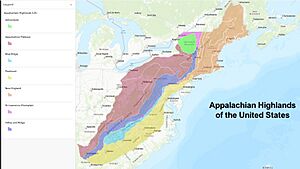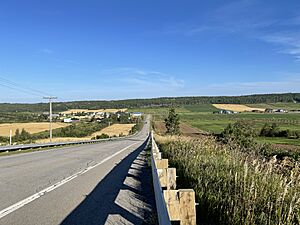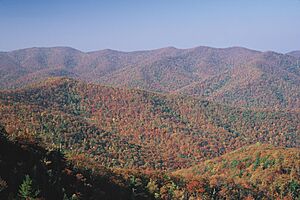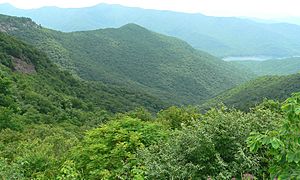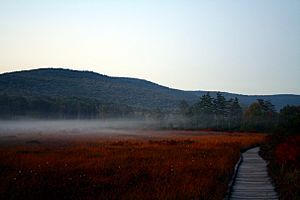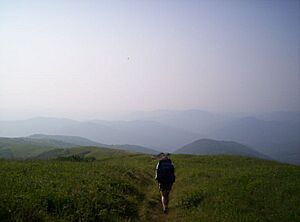Appalachian Mountains facts for kids
Quick facts for kids Appalachian Mountains |
|
|---|---|
| Appalachians | |
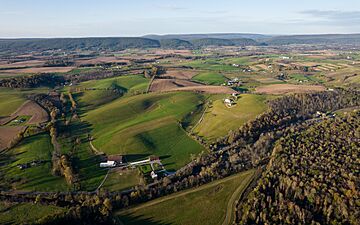
The Appalachian Mountains in the background with Penns Valley in Centre County, Pennsylvania in the foreground in October 2021
|
|
| Highest point | |
| Peak | Mount Mitchell in Yancey County, North Carolina, U.S. |
| Elevation | 6,684 ft (2,037 m) |
| Dimensions | |
| Length | 2,050 mi (3,300 km) |
| Geography | |
| Country |
|
| Geology | |
| Orogeny | Grenvillle, Taconic, Acadian, Alleghanian |
| Age of rock | Mesoproterozoic era (Stenian period)–Paleozoic era (Permian period); 1.2 billion years ago to 300 million years ago |
The Appalachian Mountains are a mountain range in eastern to northeastern North America. The term "Appalachian" refers to several different regions associated with the mountain range, and its surrounding terrain.
The highest peak of the mountain range is Mount Mitchell in North Carolina at 6,684 feet (2,037 m), which is also the highest point in the United States east of the Mississippi River.
The range is older than the other major mountain range in North America, the Rocky Mountains of the west. Some of the outcrops in the Appalachians contain rocks formed during the Precambrian era.
Contents
Where are they?
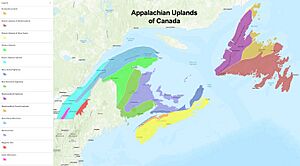

These mountains start way up in Newfoundland, Canada, and stretch all the way down to Alabama in the United States. That's a distance of about 2,050 miles (3,300 kilometers)! They even cross a tiny group of islands called Saint Pierre and Miquelon, which belongs to France. So, technically, the Appalachian Mountains are in three countries: Canada, the United States, and France!
How tall are they?
The tallest mountain in the Appalachian range is Mount Mitchell, in North Carolina. It's 6,684 feet (2,037 meters) high. That's like stacking about 668 school buses on top of each other! Mount Mitchell is also the highest point in the United States east of the Mississippi River.
How old are they?
The Appalachian Mountains are super old – much older than the Rocky Mountains in the western United States. Some of the rocks in the Appalachians were formed over a billion years ago! That's before dinosaurs even existed!
How were they formed?
A long, long time ago, the Earth's continents were all squished together. When two big continents called Laurentia and Amazonia bumped into each other, they created a super-big continent called Rodinia. The collision made the rocks fold and break, which pushed up the first mountains in the area.
Over millions of years, other things happened that made the mountains even bigger. They used to be as tall as the Alps or the Rockies, but wind and rain slowly wore them down.
Why are they important?
The Appalachian Mountains make it hard to travel from east to west. They're like a giant wall with lots of hills and valleys. This wall made it tricky for people to move west when the United States was first being settled.
The Appalachian trail
The range is the home of a very popular recreational feature, the Appalachian Trail. This is a 2,175-mile (3,500 km) hiking trail that runs all the way from Mount Katahdin in Maine to Springer Mountain in Georgia, passing over or past a large part of the Appalachian range. The International Appalachian Trail is an extension of this hiking trail into the Canadian portion of the Appalachian range in New Brunswick and Quebec.
Where did the name come from?
A long time ago, Spanish explorers were walking around Florida. They found a Native American village and wrote down its name as "Apalchen." The Spanish changed it to "Apalachee" and used it for the tribe and the area. Later, people started using the name for the mountains too.
How do you say it?
The name is pronounced locally as AP-ə-LATCH-ən. In northern parts of the mountain range, it is pronounced on the third syllable is like "lay", and the fourth "chins" or "shins". There is often great debate between the residents of the regions regarding the correct pronunciation. Elsewhere, a commonly accepted pronunciation for the adjective Appalachian is with the last two syllables "-ian" pronounced as in the word "Romanian".
Geography
Because the Appalachian Mountains are so big, it's hard to agree on exactly what they are. But the governments of the United States and Canada have special groups that study the land. These groups divide the land into regions to make maps.
In the United States, the Appalachian Mountains are part of a region called the Appalachian Highlands. In Canada, they're part of the Appalachian Uplands.
The Appalachian Highlands and Uplands are divided into smaller parts. In the United States, they're divided into provinces and sections. In Canada, they're divided into subsections.
- Northern: From Newfoundland to the Hudson River.
- Central: From the Hudson Valley to the New River.
- Southern: From the New River to Alabama.
The Appalachian Mountains have lots of valleys and ridges. The mountains don't all have the same height. Some are taller than others. But none of them are tall enough to have snow all year round. In Pennsylvania, there are over 60 mountains that are taller than 2,500 feet (800 meters). In West Virginia, there are over 150 mountains that are taller than 4,000 feet (1,200 meters).
| State or Province | Country | Physiographic Area | Highest Peak | Elev. (feet) | Elev. (meters) | Geographic Coordinates |
|---|---|---|---|---|---|---|
| Alabama | USA | Appalachian Plateau | Cheaha Mountain | 2,407 | 734 | 33.4869° N 85.8091° W |
| Georgia | USA | Blue Ridge | Brasstown Bald | 4,784 | 1,457 | 34.8745° N 83.8063° W |
| Kentucky | USA | Appalachian Plateau | Black Mountain | 4,145 | 1,263 | 36.9022° N 82.9144° W |
| Maine | USA | New England | Mount Katahdin | 5,269 | 1,606 | 45.9046° N 68.9216° W |
| Maryland | USA | Appalachian Plateau | Backbone Mountain | 3,360 | 1,024 | 39.4049° N 79.2911° W |
| Massachusetts | USA | New England | Mount Greylock | 3,489 | 1,063 | 42.3813° N 73.0957° W |
| New Brunswick | Canada | Chaleur Uplands | Mount Carleton | 2,690 | 820 | 47.2241° N 66.5233 ° W |
| Newfoundland | Canada | Newfoundland | The Cabox | 2,664 | 812 | 48.4959° N 58.2903° W |
| New Hampshire | USA | New England | Mount Washington | 6,288 | 1,917 | 44.1614° N 71.1811° W |
| New Jersey | USA | Valley and Ridge | High Point | 1,804 | 550 | 41.3206° N 74.6616° W |
| New York | USA | Adirondacks | Mount Marcy | 5,344 | 1,629 | 44.1126° N 73.9235° W |
| North Carolina | USA | Blue Ridge | Mount Mitchell | 6,684 | 2,037 | 35.7658° N 82.2655° W |
| Nova Scotia | Canada | Nova Scotia Highlands | White Hill | 1,755 | 535 | 46.7555° N 60.6350° W |
| Ohio | USA | Appalachian Plateau | Campbell Hill | 1,549 | 472 | 40.3888° N 83.6381° W |
| Pennsylvania | USA | Appalachian Plateau | Mount Davis | 3,213 | 979 | 39.7866° N 79.1751° W |
| Quebec | Canada | Notre Dame Mountains | Mont Jacques-Cartier | 4,160 | 1,268 | 48.9906° N 65.9425° W |
| South Carolina | USA | Blue Ridge | Sassafras Mountain | 3,553 | 1,083 | 35.0632° N 82.3062° W |
| Tennessee | USA | Blue Ridge | Kuwohi | 6,643 | 2,025 | 35.5625° N 83.4989° W |
| Vermont | USA | Green Mountains | Mount Mansfield | 4,395 | 1,340 | 44.5439° N 72.8143° W |
| Virginia | USA | Blue Ridge | Mount Rogers | 5,729 | 1,746 | 36.6586° N 81.5438° W |
| West Virginia | USA | Appalachian Plateau | Spruce Knob | 4,863 | 1,482 | 38.6992° N 79.5327° W |
St. Lawrence Valley
The St. Lawrence Valley is an area near the Appalachian Mountains. In the United States, it's part of the Appalachian Highlands. But in Canada, it's part of a different region called the St. Lawrence Lowlands.
Plateaus
Some areas near the Appalachian Mountains are called plateaus. These are flat areas that are high up. People in Kentucky and West Virginia sometimes call these areas "mountains," even though they're not really mountains.
Blue Ridge Mountains
The Blue Ridge Mountains are part of the Appalachian Mountains. They start in Pennsylvania and get taller as they go south. The highest point in the Blue Ridge Mountains is Mount Rogers in Virginia, which is 5,729 feet (1,746 meters) high.
Geology
The Appalachian Mountains were formed by the Earth's plates moving around. These plates crashed into each other and created mountains. Then, they pulled apart and created oceans.
The first time the plates crashed into each other was over a billion years ago. This created a super-big continent called Rodinia. The mountains that were formed during this time are called the Blue Ridge Mountains and the Adirondacks.
After a while, Rodinia started to break up. The mountains that had been formed started to wear down. The pieces of rock that wore off formed valleys and basins.
About 500 million years ago, the plates started to move back together. This created more mountains. The Taconic orogeny built much of the land that is now New England and Pennsylvania.
The third mountain-building event was the Acadian orogeny, which occurred between 375 and 359 million years ago. The Acadian orogeny was caused by a series of collisions of pieces of crust from the Avalonia Terrane, sections broken off from continent of Gondwana, with the North American Plate.
About 270 million years ago, the continents that are now North America and Africa crashed into each other. This created a super-big continent called Pangea. The Appalachian Mountains were part of the same mountain chain as the Little Atlas in Morocco.
Mineral resources
The Appalachian Mountains have lots of coal. There's also petroleum and natural gas.
Drainage
The rivers in the Appalachian Mountains flow in different directions. Some flow east to the Atlantic Ocean, and some flow west to the Mississippi River.
Flora
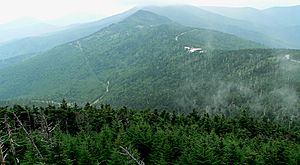
The flora of the Appalachians are diverse and vary primarily in response to geology, latitude, elevation and moisture availability. Geobotanically, they constitute a floristic province of the North American Atlantic Region. The Appalachians consist primarily of deciduous broad-leaf trees and evergreen needle-leaf conifers, but also contain the evergreen broad-leaf American holly (Ilex opaca), and the deciduous needle-leaf conifer, the tamarack, or eastern larch (Larix laricina).
The dominant northern and high elevation conifer is the red spruce (Picea rubens), which grows from near sea level to above 4,000 ft (1,200 m) above sea level (asl) in northern New England and southeastern Canada. It also grows southward along the Appalachian crest to the highest elevations of the southern Appalachians, as in North Carolina and Tennessee. In the central Appalachians it is usually confined above 3,000 ft (900 m) asl, except for a few cold valleys in which it reaches lower elevations. In the southern Appalachians, it is restricted to higher elevations. Another species is the black spruce (Picea mariana), which extends farthest north of any conifer in North America, is found at high elevations in the northern Appalachians, and in bogs as far south as Pennsylvania.
The Appalachians are also home to two species of fir, the boreal balsam fir (Abies balsamea), and the southern high elevation endemic, Fraser fir (Abies fraseri). Fraser fir is endemic to the highest parts of the southern Appalachian Mountains, where along with red spruce it forms a fragile ecosystem known as the Southern Appalachian spruce–fir forest. Fraser fir rarely occurs below 5,500 ft (1,700 m), and becomes the dominant tree type at 6,200 ft (1,900 m). By contrast, balsam fir is found from near sea level to the tree line in the northern Appalachians, but ranges only as far south as Virginia and West Virginia in the central Appalachians, where it is usually confined above 3,900 ft (1,200 m) asl, except in cold valleys. Curiously, it is associated with oaks in Virginia. The balsam fir of Virginia and West Virginia is thought by some to be a natural hybrid between the more northern variety and Fraser fir. While red spruce is common in both upland and bog habitats, balsam fir, as well as black spruce and tamarack, are more characteristic of the latter. However, balsam fir also does well in soils with a pH as high as 6.
Eastern or Canada hemlock (Tsuga canadensis) is another important evergreen needle-leaf conifer that grows along the Appalachian chain from north to south but is confined to lower elevations than red spruce and the firs. It generally occupies richer and less acidic soils than the spruce and firs and is characteristic of deep, shaded and moist mountain valleys and coves. It is subject to the hemlock woolly adelgid (Adelges tsugae), an introduced insect, that is rapidly extirpating it as a forest tree. Less abundant, and restricted to the southern Appalachians, is Carolina hemlock (Tsuga caroliniana). Like Canada hemlock, this tree suffers severely from the hemlock woolly adelgid.
Several species of pines characteristic of the Appalachians are eastern white pine (Pinus strobus ), Virginia pine (Pinus virginiana), pitch pine (Pinus rigida ), Table Mountain pine (Pinus pungens) and shortleaf pine (Pinus echinata). Red pine (Pinus resinosa) is a boreal species that forms a few high elevation outliers as far south as West Virginia. All of these species except white pine tend to occupy sandy, rocky, poor soil sites, which are mostly acidic in character. White pine, a large species valued for its timber, tends to do best in rich, moist soil, either acidic or alkaline in character. Pitch pine is also at home in acidic, boggy soil, and Table Mountain pine may occasionally be found in this habitat as well. Shortleaf pine is generally found in warmer habitats and at lower elevations than the other species. All the species listed do best in open or lightly shaded habitats, although white pine also thrives in shady coves, valleys, and on floodplains.
The Appalachians are characterized by a wealth of large, beautiful deciduous broadleaf (hardwood) trees. Their occurrences are best summarized and described in E. Lucy Braun's 1950 classic, Deciduous Forests of Eastern North America (Macmillan, New York). The most diverse and richest forests are the mixed-mesophytic or medium-moisture types, which are largely confined to rich, moist montane soils of the southern and central Appalachians, particularly in the Cumberland and Allegheny Mountains, but also thrive in the southern Appalachian coves. Characteristic canopy species are white basswood (Tilia heterophylla), yellow buckeye (Aesculus octandra), sugar maple (Acer saccharum), American beech (Fagus grandifolia), tuliptree (Liriodendron tulipifera), white ash (Fraxinus americana) and yellow birch (Betula alleganiensis). Other common trees are red maple (Acer rubrum), shagbark and bitternut hickories (Carya ovata and C. cordiformis) and black or sweet birch (Betula lenta ). Small understory trees and shrubs include paw paw (Asimina tribola), flowering dogwood (Cornus florida), hophornbeam (Ostrya virginiana), witch-hazel (Hamamelis virginiana) and spicebush (Lindera benzoin). There are also hundreds of perennial and annual herbs, among them such herbal and medicinal plants as American ginseng (Panax quinquefolius), goldenseal (Hydrastis canadensis), bloodroot (Sanguinaria canadensis) and black cohosh (Cimicifuga racemosa).
The foregoing trees, shrubs, and herbs are also more widely distributed in less rich mesic forests that generally occupy coves, stream valleys and flood plains throughout the southern and central Appalachians at low and intermediate elevations. In the northern Appalachians and at higher elevations of the central and southern Appalachians these diverse mesic forests give way to less diverse northern hardwood forests with canopies dominated only by American beech, sugar maple, American basswood (Tilia americana) and yellow birch and with far fewer species of shrubs and herbs.
Drier and rockier uplands and ridges are occupied by oak–chestnut forests dominated by a variety of oaks (Quercus spp.), hickories (Carya spp.) and, in the past, by the American chestnut (Castanea dentata). The American chestnut was virtually eliminated as a canopy species by the introduced fungal chestnut blight (Cryphonectaria parasitica), but lives on as sapling-sized sprouts that originate from roots, which are not killed by the fungus. In present-day forest canopies, chestnut has been largely replaced by oaks.
The oak forests of the southern and central Appalachians consist largely of black, northern red, white, chestnut and scarlet oaks (Quercus velutina, Q. rubra, Q. alba, Q. prinus and Q. coccinea) and hickories, such as the pignut (Carya glabra) in particular. The richest forests, which grade into mesic types, usually in coves and on gentle slopes, have predominantly white and northern red oaks, while the driest sites are dominated by chestnut oak, or sometimes by scarlet or northern red oaks. In the northern Appalachians the oaks, except for white and northern red, drop out, while the latter extends farthest north.
The oak forests generally lack the diverse small tree, shrub and herb layers of mesic forests. Shrubs are generally ericaceous, and include the evergreen mountain laurel (Kalmia latifolia), various species of blueberries (Vaccinium spp.), black huckleberry (Gaylussacia baccata), a number of deciduous rhododendrons (azaleas), and smaller heaths such as teaberry (Gaultheria procumbens) and trailing arbutus (Epigaea repens ). The evergreen great rhododendron (Rhododendron maximum) is characteristic of moist stream valleys. These occurrences are in line with the prevailing acidic character of most oak forest soils. In contrast, the much rarer chinquapin oak (Quercus muehlenbergii) demands alkaline soils and generally grows where limestone rock is near the surface. Hence no ericaceous shrubs are associated with it.
The Appalachian flora also include a diverse assemblage of bryophytes (mosses and liverworts), as well as fungi. Some species are rare and/or endemic. As with vascular plants, these tend to be closely related to the character of the soils and the thermal environment in which they are found.
Eastern deciduous forests are subject to a number of serious insect and disease outbreaks. Among the most conspicuous is that of the introduced spongy moth (Lymantria dispar), which infests primarily oaks, causing severe defoliation and tree mortality. But it also has the benefit of eliminating weak individuals, and thus improving the genetic stock, as well as creating rich habitat of a type through accumulation of dead wood. Because hardwoods sprout so readily, this moth is not as harmful as the hemlock woolly adelgid. Perhaps more serious is the introduced beech bark disease complex, which includes both a scale insect (Cryptococcus fagisuga) and fungal components.
During the 19th and early 20th centuries, the Appalachian forests were subject to severe and destructive logging and land clearing, which resulted in the designation of the national forests and parks as well many state-protected areas. However, these and a variety of other destructive activities continue, albeit in diminished forms; and thus far only a few ecologically based management practices have taken hold.
Appalachian bogs are boreal ecosystems, which occur in many places in the Appalachians, particularly the Allegheny and Blue Ridge subranges. Though popularly called bogs, many of them are technically fens.
Several mountain summits in the southern Appalachians are covered with expansive open habitats (either grassy meadows or heath) known as Appalachian balds. These habitats support many unique plant and animal communities, including rare, relict species, that are adapted to the open, exposed habitat. Their origins are heavily debated; while all were formerly thought to have anthropogenic origins, more recent evidence indicates a mixed origin: many were formed by climatic conditions in the Pleistocene and kept open by Pleistocene megafauna, then by other grazing wildlife (such as bison, elk, and deer) and Native American burning practices, and finally by grazing livestock introduced by European settlers. Others, especially those dominated by introduced grasses, may be fully anthropogenic in origin. The abandonment of grazing has caused trees to encroach on many of these balds, threatening their ecosystems.
In contrast to the largely grazing-influenced balds of the southern Appalachians, parts of the northern Appalachians such as the White Mountains. the Adirondack Mountains, and Mount Katahdin have summits covered with true alpine tundra; these ecosystems are kept clear due to extremely harsh winter storms, and support a vegetation community more akin to that of the Arctic Circle.
Fauna

Animals that characterize the Appalachian forests include five species of tree squirrels. The most commonly seen is the low to moderate elevation eastern gray squirrel (Sciurus carolinensis). Occupying similar habitat is the slightly larger fox squirrel (Sciurus niger) and the much smaller southern flying squirrel (Glaucomys volans). More characteristic of cooler northern and high elevation habitat is the red squirrel (Tamiasciurus hudsonicus), whereas the Appalachian northern flying squirrel (Glaucomys sabrinus fuscus), which closely resembles the southern flying squirrel, is confined to northern hardwood and spruce–fir forests.
As familiar as squirrels are the eastern cottontail rabbit (Silvilagus floridanus) and the white-tailed deer (Odocoileus virginianus). The latter in particular has greatly increased in abundance as a result of the extirpation of the eastern wolf (Canis lupus lycaon) and the North American cougar. This has led to the overgrazing and browsing of many plants of the Appalachian forests, as well as destruction of agricultural crops. Other deer include the moose (Alces alces ), found only in the north, and the elk (Cervus canadensis), which, although once extirpated, is now making a comeback, through transplantation, in the southern and central Appalachians. In Quebec, the Chic-Chocs host the only population of reindeer (Rangifer tarandus) south of the St. Lawrence River. An additional species that is common in the north but extends its range southward at high elevations to Virginia and West Virginia is the varying or snowshoe hare (Lepus americanus). However, these central Appalachian populations are scattered and very small.
Another species of great interest is the beaver (Castor canadensis), which is showing a great resurgence in numbers after its near extirpation for its pelt. This resurgence is bringing about a drastic alteration in habitat through the construction of dams and other structures throughout the mountains.
Other common forest animals are the black bear (Ursus americanus), striped skunk (Mephitis mephitis), raccoon (Procyon lotor), opossum (Didelphis virginianus), woodchuck (Marmota monax), bobcat (Lynx rufus), gray fox (Urocyon cinereoargenteus), red fox (Vulpes vulpes) and in recent years, the coyote (Canis latrans), another species favored by the advent of Europeans and the extirpation of eastern and red wolves (Canis rufus). European boars (Sus scrofa) were introduced in the early 20th century.
Characteristic birds of the forest are wild turkey (Meleagris gallopavo silvestris), ruffed grouse (Bonasa umbellus), mourning dove (Zenaida macroura), common raven (Corvus corax), wood duck (Aix sponsa), great horned owl (Bubo virginianus), barred owl (Strix varia), screech owl (Megascops asio), red-tailed hawk (Buteo jamaicensis), red-shouldered hawk (Buteo lineatus), and northern goshawk, as well as a great variety of "songbirds" (Passeriformes), like the warblers in particular.
Of great importance are the many species of salamanders and, in particular, the lungless species (family Plethodontidae) that live in great abundance concealed by leaves and debris, on the forest floor. Most frequently seen, however, is the eastern or red-spotted newt (Notophthalmus viridescens), whose terrestrial eft form is often encountered on the open, dry forest floor. It has been estimated that salamanders represent the largest class of animal biomass in the Appalachian forests. Frogs and toads are of lesser diversity and abundance, but the wood frog (Rana sylvatica) is, like the eft, commonly encountered on the dry forest floor, while a number of species of small frogs, such as spring peepers (Pseudacris crucifer), enliven the forest with their calls. Salamanders and other amphibians contribute greatly to nutrient cycling through their consumption of small life forms on the forest floor and in aquatic habitats.
Although reptiles are less abundant and diverse than amphibians, a number of snakes are conspicuous members of the fauna. One of the largest is the non-venomous black rat snake (Elaphe obsoleta obsoleta), while the common garter snake (Thamnophis sirtalis) is among the smallest but most abundant. The eastern copperhead (Agkistrodon contortrix) and the timber rattler (Crotalus horridus) are venomous pit vipers. There are few lizards, but the broad-headed skink (Eumeces laticeps), at up to 13 in (33 cm) in length, and an excellent climber and swimmer, is one of the largest and most spectacular in appearance and action. The most common turtle is the eastern box turtle (Terrapene carolina carolina), which is found in both upland and lowland forests in the central and southern Appalachians. Prominent among aquatic species is the large common snapping turtle (Chelydra serpentina), which occurs throughout the Appalachians.
Appalachian streams are notable for their highly diverse freshwater fish life. Among the most abundant and diverse are those of the minnow family (family Cyprinidae), while species of the colorful darters (Percina spp.) are also abundant.
A characteristic fish of shaded, cool Appalachian forest streams is the wild brook or speckled trout (Salvelinus fontinalis), which is much sought after as a game fish.
See also
 In Spanish: Apalaches para niños
In Spanish: Apalaches para niños
- Appalachia
- Appalachian American
- Appalachian League
- Appalachian Mountain Club
- Appalachian Trail
- List of subranges of the Appalachian Mountains



